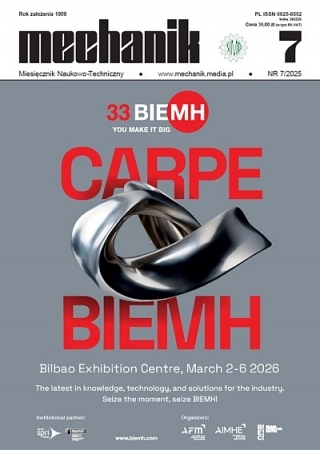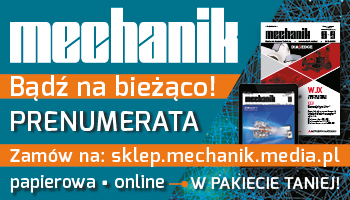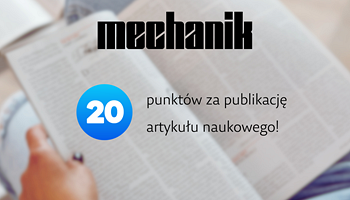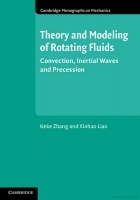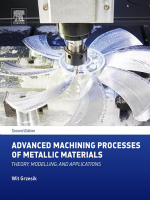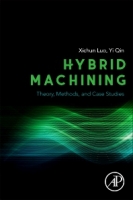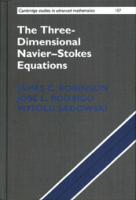Critical evaluation of key data analysis steps in roundness measurements
Krytyczna ocena kluczowych etapów analizy danych w metrologii okrągłości *
Author: Kamil Kubiak, Krzysztof Stępień
Mechanik nr 05/06/2025 - Metrologia techniczna
ABSTRACT: Analysis of roundness measurement data is fundamental for the assessment of geometric characteristics of cylindrical and spherical objects. This process comprises four essential stages: modelling, filtering, parameterization, and uncertainty budget estimation. The present work focuses on the first three stages, investigating in detail the influence of selected factors and parameters on the final measurement result. Commonly applied assumptions in roundness metrology were also subjected to verification. Research findings confirm, inter alia, that differences in amplitude roundness parameters can reach up to 50% depending on the adopted reference element (circle). Furthermore, a positive influence of applying a Gaussian filter with a broader bandwidth on amplitude parameters was observed, and the effectiveness of utilising the Fourier transform in roundness profile analysis was confirmed.
KEYWORDS: reference circles, filtering, roundness parameters
STRESZCZENIE: Analiza danych pomiarowych okrągłości ma kluczowe znaczenie w ocenie cech geometrycznych obiektów cylindrycznych i sferycznych. Proces ten składa się z czterech podstawowych etapów: modelowania, filtrowania, parametryzacji oraz szacowania budżetu niepewności. W artykule skoncentrowano się na pierwszych trzech etapach, dogłębnie analizując wpływ wybranych czynników i parametrów na końcowy wynik pomiaru. Zweryfikowano również powszechnie przyjmowane założenia stosowane w metrologii okrągłości. Wyniki badań potwierdzają między innymi, iż różnice w amplitudowych parametrach okrągłości mogą dochodzić do 50% w zależności od zastosowanego elementu odniesienia. Co więcej, zaobserwowano pozytywną korelację zastosowania filtru Gaussa o szerszym paśmie przepustowości na parametry amplitudowe, jak również potwierdzono skuteczność wykorzystania transformaty Fouriera w analizie profilu okrągłości.
SŁOWA KLUCZOWE: okręgi odniesienia, filtrowanie, parametry okrągłości
BIBLIOGRAFIA / BIBLIOGRAPHY:
[1]Raya J., Muralikrishnan B. „Computational surface androundness metrology”. London: Springer, 2008.
[2]Fanwu M., Chunguang X., Haiming L., Juan H., Dingguo X.„A quick algorithm of maximum inscribed circle methodfor roundness vvaluation”. Guiyang: 2011 InternationalConference on System Science, Engineering, Design andManufacturing Informization, 2011.
[3]Liu F., Xu G., Liang L., Zhang Q., Liu D. „Minimum circumscribed circle and maximum inscribed circle of roundness deviation evaluation with intersecting chordmethod”. IEEE Transactions of Instrumentation and Measurement. Vol. 65, No. 12 (2016): pp. 2787÷2796.
[4]Yao Y., Zhang K. „An improved self-born weighted leastsquare method for cylindricity error evaluation”. Applied Science. Vol. 12, No. 23 (2022): pp. 12÷19.
[5]Zhi-min C., Yuan W., Jian H. „Roundness deviation evaluation method based on statistical analysis of local leastsquare circles”. Measurement Science and Technology.Vol. 28, No. 10 (2017): pp. 1÷20.
[6]Adamczak S. „Odniesieniowe metody pomiaru odchyłkiokrągłości części maszyn”. Kielce: Wydawnictwo Politechniki Świętokrzyskiej, 1998.
[7]Podulka P. „Comparisons of envelope morphologicalfiltering methods and various regular algorithms forsurface texture analysis”. Metrology and MeasurementSystems. Vol. 27, No. 2 (2020): pp. 243÷253.
DOI: https://doi.org/10.17814/mechanik.2025.5-6.3
* Artykuł recenzowany


